Neville George Griffin, known to everyone as ‘Bill’ was born in India on the 25th September 1923. The exact location was Clifton Murray Hills, which is now part of Pakistan. His name came about as a result of their Afghan cook not being able to pronounce ‘Neville’, it always came out as ‘Bill’.
His father had been a soldier with the Oxfordshire & Buckinghamshire Light Infantry, who had seen service in the Great War and decided to settle in India, signing on with the Indian Army Ordnance Corps.
On 22 April 1938, Bill joined up as a boy soldier, aged 14 years and 6 months, in Kirkee, India. Just three days later he was on a troopship bound for England. He was sent to Buller Barracks in Aldershot to undertake his 3 years training as a Clerk in the Royal Army Service Corps, before being sent to his first post at Reigate. Here he worked for Gen Bernard Montgomery as a member of South East Army Command in 1941. He took regular dictation from the General using his skill as a shorthand writer - a skill that would make him invaluable to senior officers throughout his career.
Aged 17 ½, he was finally old enough to join up for Regular Service and quickly volunteered for the newly forming-up Airborne Forces after passing a stringent medical. One of his first appointments was as a shorthand Clerk and Typist to General Browning, the first GOC of the Airborne Division. As part of AQS Staff he was also answerable to Lt-Col J A Goschen, the first Assistant Adjutant & Quartermaster General of the Airborne Division.
In April 1943 the renumbered 1st Airborne Division was ordered to mobilise for North Africa. Bill travelled by troop train from Bulford to Liverpool docks, where he embarked on the H.M.T. Stirling Castle. From Liverpool they sailed to Garoch in Scotland where the convoy formed up to sail for Oran in Algeria, landing in May. From here they moved to Mascara in Tunisia where the 1st Airborne Division was preparing for the invasion of Sicily.
At this stage Bill had a new ‘boss’, Maj-Gen.G.F. 'Hoppy' Hopkinson. Whilst very busy typing out the orders for Operations FUSTIAN and HUSKY, ‘Bill’ still found time to undertake a parachute course. He carried out five jumps, including one by night. Having become parachute qualified he was attached to the 2nd Parachute Brigade for further operations on 10 July 1943, but the operation was cancelled.
After operations on Sicily were completed the ‘remnants’ of the 1st Parachute & 1st Airlanding Brigade’s returned to their respective camps in North Africa. Bill was again kept very busy, sometimes long into the night, typing out the orders for the 1st Airborne Division’s next major deployment – the invasion of Southern Italy. They eventually set sail for the Italian port of Taranto in September 1943. The Royal Naval task force consisted of the Capitol ships HMS Nelson & Howe with the USS Boise attached for the operation. ‘Bill’ and the Divisional Headquarters element sailed in HMS Aurora. From Taranto the main part of 1st Airborne Division (including Bill) pushed the German forces back past Foggia in October. The conditions were quite appalling on the flat open ground of the Foggia airfield area and every time it rained the plain flooded, inducing a very high rate of jaundice among 1st Airborne troops before they were eventually relieved by General Montgomery’s 5th Corps of the 8th Army.
In December 1st Airborne Division moved back to Taranto to begin their relocation back to the United Kingdom. The convoy that Bill was in sailed back to Liverpool and straight from docking they were sent to the ‘new’ Divisional Headquarters at Fulbeck Hall in Lincolnshire. Given two weeks disembarkation leave, in the New Year of 1944, it was spoilt by him falling ill. After his recovery in hospital he was sent to a ‘Holding Depot’. The authorities wanted to post him to a Line Infantry Unit, but Bill protested he was a trained Airborne Soldier and was thus posted back to the 1st Airborne Division.
Along with the Divisional planning staff Bill regularly travelled to Moor Park where the various further airborne operations were planned after ‘D-Day’. Lieutenant-Colonel P.H.H.H.Preston, who was now Bill’s immediate ‘boss’ would let him visit his fiancé, Dorothy, who lived nearby, on the strict instructions that he did not say a word about what they were doing in the area. Finally, after numerous cancellations, Operation Market commenced as the next operation for 1st Airborne Division in September 1944.
On Sunday 17 September 1944, Lt-Col Preston, Bill, S.S.M. George Fairhurst and Cpl. Norman Davidson flew from RAF Fairford in a Horsa glider loaded with a jeep and trailer flown by men of 24 Flight, G-Squadron, The Glider Pilot Regiment to L.Z. ‘Z’ near Heelsum in Holland as part of ‘Operation Market-Garden’. Bill was not particularly happy about going by glider, as a trained parachutist he would have preferred to be ‘jumping in’ on the operation:
"Lieutenant-Colonel Preston, the A.A & Q.M.G., a South Lancashire Regiment officer, insisted I go with him in his glider as he wanted me to take his little black leather office box. We were the second glider out of Fairford, and I did not enjoy the ride!"[1]
They encountered some flak as they crossed the Dutch coast and upon landing another glider cut across their front causing the pilot of their own glider to veer away. Although no one was hurt the nose was dug-in and the tail high in the air, with Bill’s typewriter lost in the crash. Once on the ground the situation from Bill’s point of view did not improve as he witnessed other gliders landing:
"Hamilcars had a problem landing. I saw a glider pilot screaming from his injuries following a bad landing. I gave him morphine and left him. It was all I could do for him." [2]
The small team of men as part of the 1st Airborne Divisional Headquarters element moved into the woods on the Eastern side of the L.Z. towards Wolfheze and set up their ‘Q’ Cell: a supporting office for the A.A. & Q.M.G. in which the Logistics Staff were to work. Later when the HQ came under sustained German mortar fire they had to move back amongst the gliders and set up under the wing of a Hamilcar.
On Monday 18th the Divisional HQ moved to a new location in the small village of Oosterbeek, arriving there at 17.30 hours:
"We formed up and marched up the main road to the Hartenstein [Hotel]. We thought it was just like an exercise. We went past the body of General Kussin. We went straight into the cellar." [3]
By Tuesday 19th things were no longer like an exercise and the fire into their area from German guns was beginning to increase. The main problem now was that the Germans held the re-supply dropping zone and numerous methods were used to try and redirect the aircraft:
"Re-Supply signals used to be put into SLIDEX (a simple code system used by the British Army up to the 1980’s). We got a couple of supply drops through. Stanley Maxted (a BBC reporter) was there, and passed re-supply information through the BBC link and then onto 1st Airborne Corps. On one occasion Colonel Preston sent me out with a Verey pistol to attract pilots attention, but the Germans were doing the same thing on the perimeter and it was to no avail." [4]
On Wednesday the 20th life around the Divisional HQ was decidedly unhealthy and getting worse:
"Colonel Preston told me he wished to see Colonel Packe [the C.R.A.S.C.], and asked me to go and get him. I asked Norman Davidson to come with me. “Not likely” was the immediate reaction, but he came anyway. We crossed the main road, and saw a house with a dim light which was a cellar. I stuck my head in and said, “Colonel Packe?”. I was lucky not to get shot. I told him he was wanted, and with a very unhappy Colonel Packe we padded back across the road." [5]
Eventually Lieutenant-Colonel Packe and his small admin staff moved into a slit trench near the Hartenstein HQ, being quite near the AQ office it would much easier for Bill to get Colonel Packe next time!
Between Thursday the 21st and Monday the 25th it was one continuous round of bombardments from the encircling German forces. On the night of 25th September Bill and the other AQ Staff were told about Operation 'Berlin’, the evacuation plan for what remained of the 1st Airborne Division:
"We were gathered together and told about the taping of the route to the river. I had the great joy of smearing Colonel Preston’s face with lamp black from the Tilley lamp. We were told that if a man was wounded he was to be left behind. It was my twenty-first birthday, and I thought ‘today I’m going to die’. I never thought I’d see my twenty-first birthday out. Three of the Divisional Headquarters Clerks got out: Corporal Daniel Lewis, Corporal Norman Davidson and myself. I got out in a Canadian boat. We couldn’t start the engine and it was drifting down the river before we eventually got it going. Having got over I headed for a Dorset [Regiment] soup kitchen. Heading back from the river in a DUKW it slipped on a dyke and we all ended up in the ditch, but the driver got it out and drove us to Nijmegen." [6]
Upon their return to the U.K from Holland, via Belgium, they were taken straight back to Fulbeck Hall. After a couple of days they were sent on survivors leave.
Their priority on return to Fulbeck Hall was sorting out and collating the various citations for bravery. They were set a time limit by the authorities as the 1st Airborne Division was to be on parade at Buckingham Palace on the 6th December 1944. Bill, however, would not be attending the parade as he had been given permission to marry, the big day taking place on 9th December 1944 in Abbey Wood, Woolwich.
By May 1945 the Division had been brought back up to strength and they were tasked with liberating Norway and taking the surrender of the German garrison there. Bill sailed to Norway in an L.S.T. via Leith in Scotland with the AQ Office truck. He remained in Oslo until October when the Division was returned to the U.K. Whilst in Norway he was awarded the King Haakon Medal.
At the end of the Second World War the 1st Airborne Division was finally disbanded and Bill attended the service held in Salisbury Cathedral on their return for the disbandment of the 1st Airborne Division. Bill's Airborne career was not yet at an end however. He was subsequently sent as Chief Clerk to 1st Parachute Brigade HQ as a Staff Sergeant, where he helped Brigadier Hill set up the Parachute Regiment Association (PRA).
Early the following year, in February 1946, Bill went with the Brigade to Palestine, where he worked for Brigadier Hugh Bellamy (he sometimes scared other Senior Officers as he was a very strong willed character). His ability was soon recognised and in November 1946 Bill gained promotion to Warrant Officers Class II and was posted to 6th Airborne Divisional HQ (against the wishes of Brigadier Bellamy!). At Divisional HQ he took on the task of Chief Clerk aged just 23 years old. His immediate ‘boss’ was now Maj Gen Eric Bols. During this period he was awarded a Mention In Despatches.
He remained in Palestine for most of the deployment, finally returning to the UK in April 1948 with the remnants of 1st Parachute Brigade, before being posted to 2nd Parachute Brigade HQ in Germany (which was renumbered 16th Independent Parachute Brigade Group). He stayed with the Brigade until 1952, and was posted to the Canal Zone Egypt, via Cyprus - his final Airborne deployment.
In January 1953 he was posted to the RMAS Sandhurst where he remained until April 1956, during which time he formally gained the rank of Warrant Officer Class 1 (WO1). Postings with 138 Supply Company and later G-Branch, HQ British Army of the Rhine (BAOR) followed in Germany until 1960, when he returned to the UK for three years with Western Command, at Chester, gaining his commission in December 1962.
In January 1963 he was posted to Singapore in the 3 Army Air Supply Organisation as Air Despatch Officer for 55 Air Despatch Company, Royal Army Service Corps. Returning to the UK in August 1965, he was posted for next two years as Staff Captain of Q-Branch, HQ Yorkshire District at Catterick. He received his MBE during this time.
In 1967, he was posted to the MOD as Staff Officer to the Chief Of The Defence Staff. He was promoted to Major after just 11 months as a Captain. Between 1969 and 1978 Bill undertook various Staff Appointments, having transferred to the Royal Army Ordnance Corps and was made responsible for promotions and postings, gaining his final promotion himself to Lieutenant-Colonel on 24 September 1972.
After a long and distinguished career, he finally left the Army in 1978, and lived in the Amesbury area where he moved with his wife in 1977.
Sadly Neville passed away on the 2 July 2017.
References
Main information taken from an interview with Bob Hilton. 19/02/10.
[1] [2] [3] [4] [5] [6] quoted from Brig Frank Steer, Arnhem: The Fight To Sustain, the untold story of Airborne Logisticians, (2001), Pen & Sword.
Compiled with assistance from Bob Hilton
Read More
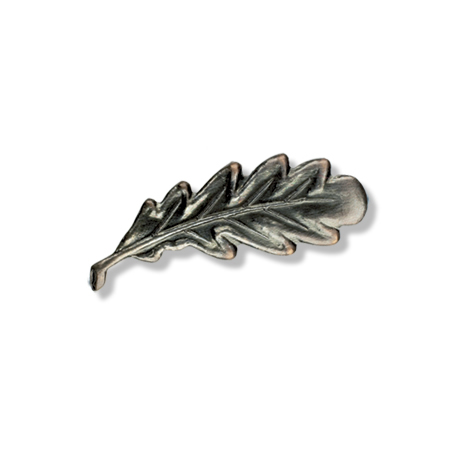



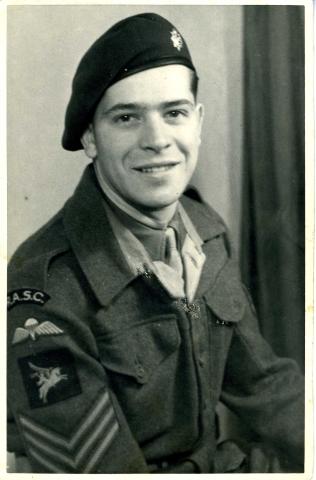
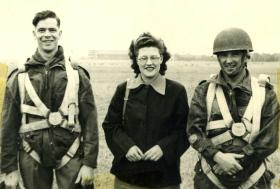
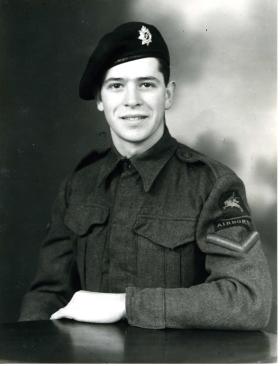
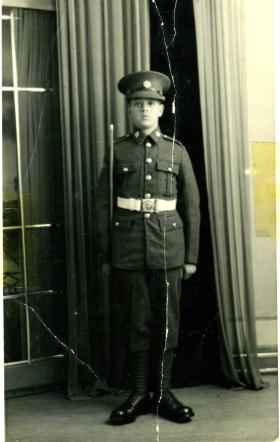
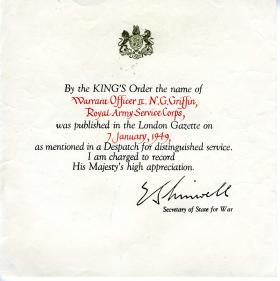
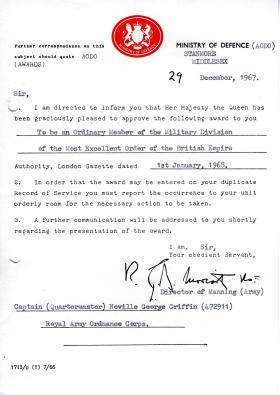
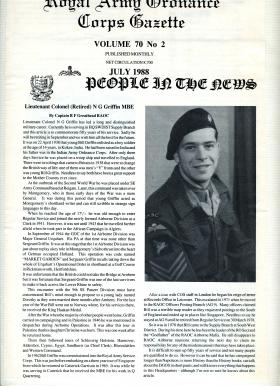
Latest Comments
There are currently no comments for this content.
Add Comment
In order to add comments you must be registered with ParaData.
If you are currently a ParaData member please login.
If you are not currently a ParaData member but wish to get involved please register.